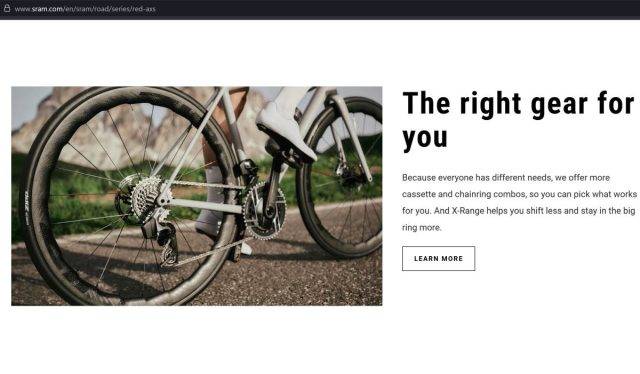
On September 12, 2025, SRAM filed a formal complaint with the Belgian Competition Authority (BCA) against the Union Cycliste Internationale (UCI) disputing the UCI’s Maximum Gearing Protocol. The BCA initiated formal anti-trust proceedings under EU and Belgian competition laws on September 17, 2025, after reviewing SRAM’s complaint.
SRAM sought assistance from the BCA in the matter because the authority is well positioned to pursue the matter and has demonstrated a commitment to fairness and integrity in sport. The Prosecutor General of the BCA will conduct an investigation and present the findings to the Competition College, the impartial decision-making body of the BCA, for an ultimate ruling.
SRAM is challenging the UCI’s gearing restrictions for selected events, which limit gear rollout to a maximum of 10.46 meters per pedal revolution — equivalent to a 54×11 gearing configuration. This restriction excludes drivetrains that exceed this threshold, primarily SRAM’s RED AXS drivetrain in a 54×10 configuration, a preferred choice for many of SRAM’s professional teams.
SRAM is the only major manufacturer whose current pro team setup will be blocked by the new UCI regulations — regulations that hinder innovation, limit rider choice, and unfairly disadvantage SRAM riders and SRAM.
SRAM made multiple attempts to engage the UCI and raise concerns about the impact of the Maximum Gearing Protocol on SRAM riders, teams, and SRAM itself. Despite these eYorts, UCI leadership declined to engage in meaningful dialogue regarding the rule’s validity or its basis. While SRAM continues to participate in technical discussions to help teams comply with the restrictions at the announced gearing-restricted race, the lack of transparency and collaboration left legal action as the only remaining path forward.
“This protocol penalizes and discourages innovation and puts our riders and teams at a competitive disadvantage. We could not have imagined the drivetrains of today when SRAM was founded nearly 40 years ago, and we know the drivetrains of the next decade will continue to evolve. We rely on the sport’s governing body to foster an environment that encourages innovation for the benefit of riders and racers today, and riders in the future,” said Ken Lousberg, SRAM’s CEO. “We also rely on the governing body to make science-based, impactful changes for rider safety. We are the harshest critics of our own equipment that is raced and ridden around the world; safety is paramount to us.”
Although the UCI refers to the Maximum Gearing Protocol as a “test,” its implementation has already caused tangible harm. SRAM’s gearing has been publicly labeled as non-compliant, creating reputational damage, market confusion, team and athlete anxiety, and potential legal exposure. It is for these reasons SRAM has also sought immediate injunctive relief, halting the gearing restriction requirement at the Guangxi event and any future events.
If the gearing restriction is not lifted, racers using unmodified SRAM drivetrains risk disqualification and financial penalties, and SRAM-sponsored teams face immediate disadvantages that impact race results and potential sponsorship opportunities. Further, SRAM and its supplied teams have not been able to adequately test limiting gearing in such a way, creating unnecessary risk for SRAM-equipped riders.
The UCI has designated the Tour of Guangxi for enforcement but has indicated that additional events may follow, leaving SRAM and its sponsored teams, both current and future, in a state of uncertainty.
“Calling it a test doesn’t make it any less of a race,” Lousberg said. “All riders on the start line should be able to compete on equal footing. Right now, SRAM-equipped teams will have to race at a disadvantage on compromised equipment with a reduced number of gearing options compared to their competitors. It’s also not clear what is being tested.”
SRAM’s complaint alleges that the UCI Maximum Gearing Protocol:
- Was adopted without consultation or transparency and lacks supporting empirical evidence, and any safety justification.
- Disadvantages SRAM-equipped riders in professional cycling events.
- Distorts competition in the road drivetrain market by limiting choice for professional teams and ultimately consumers, as SRAM relies on top-level teams to use and market its products.
- Violates EU and Belgium competition law (Articles 101 and 102 TFEU).
While the UCI has framed the protocol as a safety initiative, no evidence has been presented to support such claims. SRAM’s analysis of crash data from the 2025 Tour de France, using telemetry and footage, found no correlation between higher rollout configurations and crash risk. Crashes on descents were rare and occurred at speeds achievable on gearing configurations from all suppliers for WorldTour teams.
“If you talk to riders across the sport, they are asking for safer races, for better course designs,” Lousberg said. “There are things we as a collective can do to help make races safer, but arbitrarily restricting a gearing choice—a gearing choice that only we provide to our teams—is fundamentally unfair to teams, riders, and SRAM.”
SRAM spent nearly a decade developing a modern gearing philosophy that has reshaped road cycling and has been embraced by weekend riders and Tour de France champions. SRAM intentionally moved beyond the 11-tooth as the lowest gear, favoring a more innovative drivetrain architecture. Complying with the protocol would require a full redesign and technical step back — a process that would take years.
Due to UCI’s baseless assertions, the public may already mistakenly view SRAM’s gearing as illegal, exposing SRAM to reputational harm and potential liability. If the restriction becomes permanent, retailers and OEMs may abandon SRAM products, jeopardizing SRAM’s market share in high-performance road drivetrains.
“We’re proud of the position we’ve earned in the market over nearly four decades,” said Lousberg. “It’s not something we’re willing to relinquish because of arbitrary drivetrain restrictions imposed by a governing body — and we won’t back down without making our case.”
As part of its complaint, SRAM requests the immediate suspension of the gearing restrictions, representation for bike and equipment manufacturers on the board responsible for equipment rulings and changes, and the establishment of internal procedures that ensure future UCI regulatory eYorts comply with EU competition law.
“Today, the UCI’s actions unjustly penalize SRAM riders and SRAM,” Lousberg said. “But given the way the governing body makes its decisions — decisions such as handlebar width, rim depth, the recent transponder implementation and penalization of teams in Romandie… even sock height — it’s impossible to know who may be impacted in the future. Through this process we hope to create a more transparent and collaborative climate for teams and component suppliers that ultimately leads to a better and safer sport for all.”
SRAM is committed to rider safety, fair competition, and open dialogue with all stakeholders. SRAM believes that progress in cycling comes from collaboration, transparency, and a shared commitment to innovation. We are committed to riders across the world and will continue to develop innovative and industry-leading equipment that meets the highest safety and performance standards. SRAM looks forward to helping build a better future for racers, riders, and fans of the sport of cycling.
Frequently Asked Questions
What is the UCI’s Maximum Gearing Protocol?
On June 12, 2025, the UCI adopted a protocol limiting gear rollout to 10.46 meters per pedal revolution, equivalent to a 54×11 gear configuration. This eDectively bans drivetrains like SRAM’s RED AXS 54×10 and 56×10, which exceed the limit.
Why does this protocol a@ect SRAM specifically?
SRAM is the only company, at scale, equipping teams and riders across the world with drivetrains that exceed the rollout limit. The protocol forces SRAM to mechanically disable its 10-tooth cog, reducing gear options and placing SRAM-equipped riders at a competitive disadvantage.
What are the consequences for riders using SRAM’s unmodified drivetrains?
Riders potentially face disqualification and financial penalties if they use non-compliant SRAM drivetrains in UCI-sanctioned events implementing the protocol.
Can SRAM redesign its drivetrain to comply?
A compliant alternative would require a complete redesign, estimated to take years, significantly impacting SRAM’s ability to compete in racing and the broader cycling market. In terms of innovation and capability, this imposed restriction is a step backward for both the rider and the bicycle.
How does the protocol a@ect competition in the drivetrain market?
The protocol:
- Harms SRAM-equipped professional teams
- Disparages SRAM in the road drivetrain market
- Distorts competition, favoring manufacturers with compliant gearing (e.g., Shimano)
What are the long-term risks for SRAM if the protocol remains?
- Reputational damage and potential civil liability
- Loss of retailer and OEM support and confidence
- Erosion of global market share
- Up to a decade of reinvestment to recover
Is there any evidence supporting the rollout restriction?
No. The protocol is said to be based on a non-transparent and non-scientific rider survey focused on Shimano-compatible setups. There is no empirical data or analysis linking higher rollout ratios to crash risk.
Has SRAM conducted its own safety analysis?
Yes. SRAM meets or exceeds all safety requirements outlined by ISO, the International Organization for Standardization. In addition to industry standard tests, SRAM has developed and improved our own proprietary tests based on years of lab and real-world experience. Additionally, SRAM analyzed crash data from the 2025 Tour de France using telemetry and footage. The findings showed no correlation between rollout and crash risk. Descents where 54×10 might be used were rare and low risk.
Is the designated test suitable for evaluating crash risk?
No. The logic of the test is flawed in the fact that it excludes the very item it needs to measure. As structured, the test is positioned to validate a flawed hypothesis.
Is there transparency around the rollout testing process?
No. No public information has been provided regarding testing frequency, scope, or methodology.
What legal violations does SRAM allege?
SRAM’s complaint cites violations of:
Articles 101 and 102 of the Treaty on the Functioning of the European Union (TFEU)
Articles IV.1 and IV.2 of the Belgian Code of Economic Law (CEL)
What is SRAM seeking through its complaint?
SRAM aims to:
- Suspend the protocol
- Restore fair competition
- Ensure transparent, proportionate, and non-discriminatory regulation by the UCI
- Gain representation for manufacturers on the UCI equipment board
- Establish internal procedures to ensure future UCI regulations comply with EU competition law
Why is the Belgian Competition Authority (BCA) involved?
SRAM filed its complaint with the BCA because:
- The BCA has jurisdiction under EU competition law
- The BCA is well positioned to pursue the matter and has demonstrated a commitment to fairness and integrity in sport
What are the next steps in the process?
The Prosecutor General of the BCA will conduct an investigation and present the findings to the Competition College, the impartial decision-making body of the BCA, for an ultimate ruling.
Is SRAM committed to rider safety?
Absolutely. SRAM prioritizes safety and innovation. Its drivetrain designs are rigorously and continually tested, and its crash data analysis supports safe performance across all rollout configurations.
How can consumers and retailers support SRAM?
- Staying informed
- Commenting constructively on social platforms
- Continuing to use and promote SRAM products
- Advocating for fair competition and transparent regulation in cycling
Press release by SRAM.


This is a stupid rule but why would SRAM need to completely redesign their drivetrain? Could they not just create a cassette with an 11-tooth starting cog and have their riders run an 54-11 like everyone else has been doing for years? I would like to see the rule be reversed but come on SRAM. If you are so smart you can figure this out.
SRAM’s 10T cog has a built in lockring that fixes the cassette to the XDR body. They would need a redesign to accommodate an 11T starting cog, something I would prefer… I never use that 10T cog. However, all of this is moot as a Belgian court ruled in SRAM’s favor, and chucked the UCI’s bollocks out. With that said, another simpler solution would be to use a 49T chainring to negate the gear ratio / rollout issues the UCI was ticked off about.